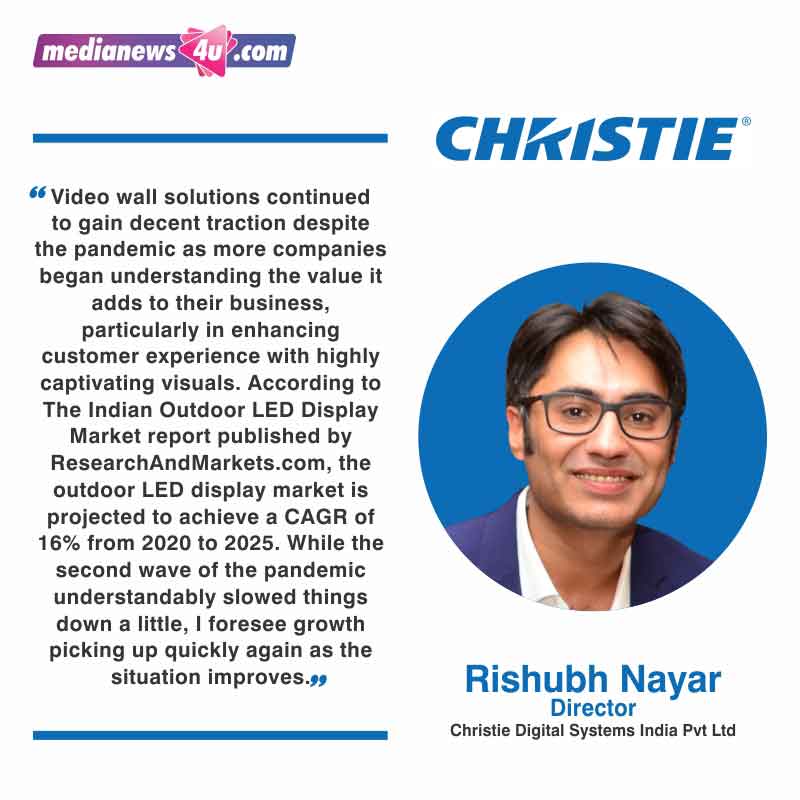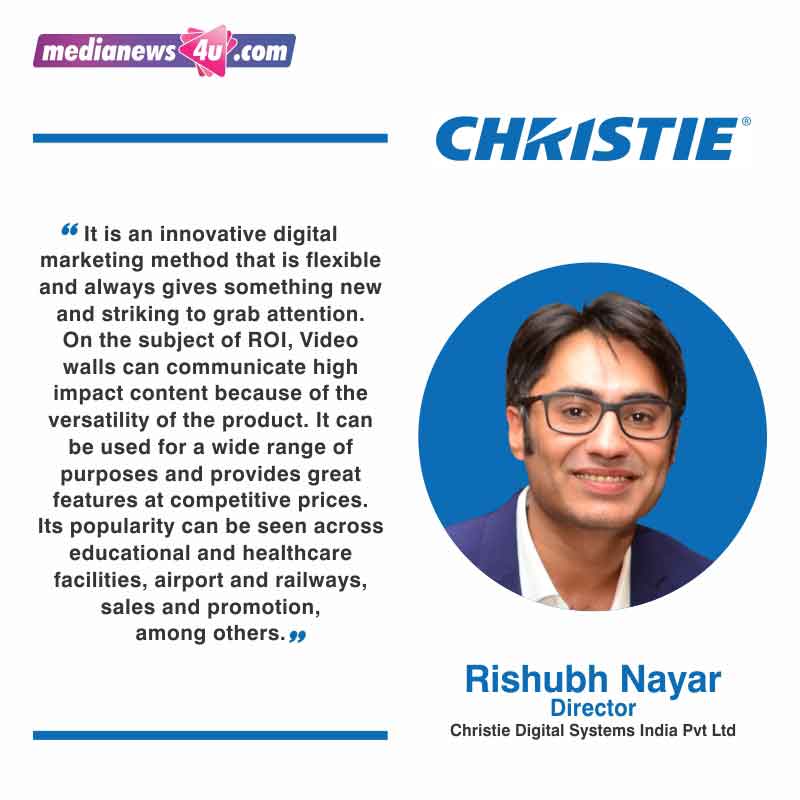Christie is a global audio-visual, content management, and image processing Technologies Company specializing in solutions for cinema, business, education, entertainment, and industry.
Christie has brought great ideas to life for more than 90 years. From the first projectors built in 1929 to digital cinema projection that revolutionized the movie industry, Christie has lead the way and help their partners create amazing shared experiences. So much has changed in the last few years, looking forward with eager anticipation to what the future holds.
In an exclusive chat with MediaNews4U, Rishubh Nayar, Director, Christie Digital Systems India Pvt Ltd talks on the business in India, the tectonic shift in the ways brands are now communicating, the trends and the way forward.
What makes video walls different from other digital signage options or display screens? What does it offer that others don’t?
Video walls have been a known technology across applications. Digital signage is one vertical segment where video wall technology has been increasingly used. This is not only because they are eye-catching, but also in terms of performance, reliability, installation flexibility, and ease of maintenance. When compared with other image-display technologies, video walls feature a number of advantages in areas such as brightness, colour gamut, service life, power consumption and form factor.

They are also uniquely adaptable to a wide variety of applications irrespective of size, shape, viewing distance and environment. A lot of brands are investing in video walls due to the flexibility they provide – which is demonstrated by the versatility in customizing the kinds of shapes and sizes required. Also, the brightness and venues of installation can be completely managed by the user.
Generally, the impression many businesses have on video walls are that it can be costly. However, we have also seen a surge in growth for video walls in recent years. What are the key factors that have helped change the perception about video walls?
A lot has changed with video walls over the past years, particularly in terms of technology. In the past, the bezel sizes of tiled LCD displays used to be around 5.5mm, but now the bezels have been significantly reduced to 0.44mm, so we are getting a much larger viewing area and better aesthetics. Similarly with LED tiles, the pixel pitches are getting narrower and less prominent (from a distance).
What used to be a standard 4mm pixel pitch has now been reduced to 2.5mm at almost the same price point. Therefore, the advancement in technology has led to a correction in pricing of such products as well. Additionally, deploying a video wall is not too difficult if you have the right solutions partner to work with you every step of the way towards building dynamic and engaging designs for successful advertising or marketing campaigns.

In India, what type of industries can benefit most from video wall display solutions and which industry has set the benchmark so far?
I would say all industries, regardless of whether it is a corporate organization using them for their lobby displays or boardrooms to network operations centres (NOCs), government (command and control rooms) and entertainment venues (sports facilities, theme parks and concert walls), video walls are used in pretty much every application today. Thanks to high-performance capabilities, versatility, and flexibility, indoor LED video walls in particular are fast gaining popularity in India in various market segments.
Do you see the pandemic having an impact on this segment? Do you think it will increase the usage of video walls?
The current COVID-19 pandemic has had an impact on various industries, and the proportionate impact has been seen on the usage of video walls as well. Having said that, video wall solutions continued to gain decent traction despite the pandemic as more companies began understanding the value it adds to their business, particularly in enhancing customer experience with highly captivating visuals. According to The Indian Outdoor LED Display Market report published by ResearchAndMarkets.com, the outdoor LED display market is projected to achieve a CAGR of 16% from 2020 to 2025. While the second wave of the pandemic understandably slowed things down a little, I foresee growth picking up quickly again as the situation improves.

In the last one year alone, over 20 large-sized video walls have been installed in corporate, financial, information technology, medical and healthcare facilities, and educational institutions in India. We’re in a good position to see the progress as Christie’s LED video wall solutions became the preferred choice for big name organisations such as information technology giants Cognizant and Wipro, American-Swiss medical company Alcon, technical and research institute IIT Indore, as well as an American multinational financial institution with several branches in India.
How does a video wall improve the management of digital content and impact ROI for a business?
There is certainly an improvement in the management of digital content, especially in applications such as digital signage and advertising where branding is emphasized in venues where there is significant footfall. Nowadays video walls have a huge impact not only in differentiating the brand, but also in ensuring that it stands out and gets noticed by the public and consumers at large. Digital content often targets a large number of potential clients and video walls are a great way to share information and entertain people at the same time.
It is an innovative digital marketing method that is flexible and always gives something new and striking to grab attention. On the subject of ROI, Video walls can communicate high impact content because of the versatility of the product. It can be used for a wide range of purposes and provides great features at competitive prices. Its popularity can be seen across educational and healthcare facilities, airport and railways, sales and promotion, among others.

How easy is it to manage and maintain a video wall display? Is it more convenient than other means of digital display?
With the continuous advancement in technologies, the installation and maintenance of video wall displays have improved considerably as well. Currently, pretty much all technologies from LCD or LED can be installed and maintained from the front (instead of the rear for older models), which greatly simplifies the installation process and the subsequent maintenance regime. Top-quality video walls use remote video sources, controllers, and power supplies which helps reduce maintenance and disruption. The technical design of the tiles enables accurate alignment to its nearest neighbour which forms a seamless composite image and can be arranged to meet almost any size.
Moving forward, what are the new trends that you anticipate when it comes to innovative marketing ideas in the digital out-of-home advertising segment?
To be honest, there are so many innovative and creative ways to set up video walls nowadays. You can do almost anything with them as there is so much installation flexibility. Take for example, our Christie MicroTiles LED. The LED tiles can be arranged in near-limitless ways including 90-degree inside/outside corners, concave and convex curves to form a 360-degree immersive video wall. Alternatively, users can also mount them on a ceiling or create edge-to-edge installs. Coupled with superior visual quality aided by powerful processing including 12-bit input sources, 4K@120Hz and HDR10 compatibility, as well as high-brightness and cinema-quality color, MicroTiles LED is a great choice to deliver exceptional true-to-life details. So, whatever you can think of is now possible with advanced video wall displays.























